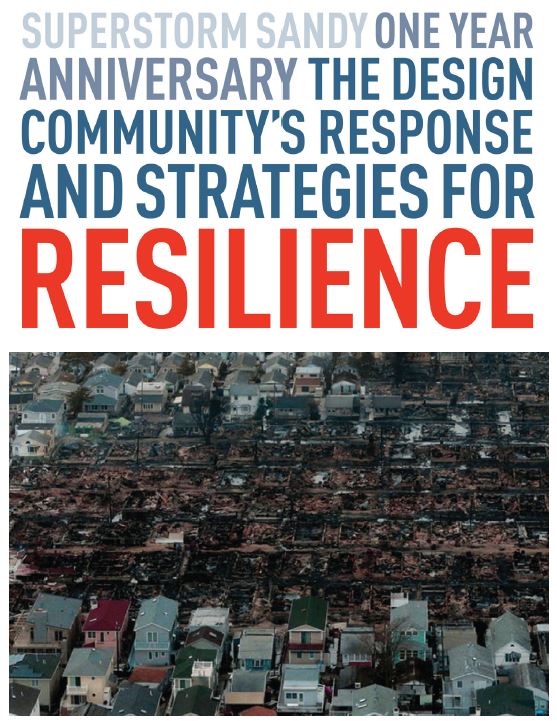by: Greta Hansen
Nearing the first anniversary of Superstorm Sandy, the AIA New York Chapter, Architecture for Humanity, and Cooper Union organized a symposium to report on and measure programs in place and steps still to be taken in the wake of the 2012 storms. The focus was resiliency, with the speakers presenting work done so far – and work still to do – in exploring approaches for future resiliency.
Such a topic demands pragmatism, but many of the speakers also stressed the need for experimentation in design. Robert Lane, senior fellow for urban design at the Regional Plan Association, pointed out that flooding alone, so often identified as the primary problem, should not be the only focus. He also warned that too much attention to speed in disaster recovery often causes communities to overlook long-term goals. He identified “shovel-ready” projects as potentially dangerous. Lane reminded us that the design community, which so often fails to respond quickly, can be better used as a tool for experimentation and research to form new ways of mapping damage and resiliency. Mary R. Rowe of the Municipal Arts Society presented a program called Rebuild by Design, a competition sponsored by the U.S. Department of Housing and Urban Development to fund design innovation on many scales. Rowe credited “weird, off-the-path interventions that often contravene jurisdiction” as some of the best and most surprising design solutions to Sandy.
There was a general consensus that “government can’t always be the tent.” Rachel Minnery, AIA, LEED AP, Regional Program Director for Architecture for Humanity’s Hurricane Sandy Reconstruction Program, presented projects such as ReNEW Schools – a program in partnership with Nike to identify and rectify issues in schools still suffering after Sandy, and ReSTORE – a partnership with MTV for a new event space in Seaside Heights, NJ. In addition to numerous other initiatives, these programs suggest the need to use corporations to fill cracks within the system. Lane took this one step further, asking, “What is better – small and green or big and grey?,” suggesting that future projects might need to compromise with larger, potentially less ecologically ideal projects in order to make an impact. “And we’ll have to collaborate with big capital in the end.”
Beyond collaborations with for-profit companies, however, it was clear that forming partnerships was a necessary response to Sandy’s massive series of unanswered questions. Ilya Azaroff, AIA, who co-chairs the AIANY Design for Risk and Reconstruction Committee, also partnered with Architecture for Humanity to organize training in coastal communities, and has worked with the NYC Department of Design + Construction on beach reconstruction, sand dunes, resilient grasses, and re-structuring the shoreline. But he also recommended one very simple fix: rethinking what we call natural disasters. If a 100-year flood happens every year, he said, a less misleading name could be the next step in planning for it.
Every speaker presented work(s) in progress. Some, like Susan Chin, FAIA, of the Design Trust for Public Space, were rushing to complete work before the change-over to a new mayoral administration. Others, like Kevin Bone, FAIA, a professor and director of Cooper Union’s Institute for Sustainable Design, and Timothy Boyland, AIA, who helped to found Staten Island SImagines, just want to involve the voices of students and normal citizens in a debate that affects us all. Even one year later, all of the speakers were eager to continue work adapting our cities and regions to an unknown future.
Greta Hansen is a New York-based architectural designer and writer.
Event: Superstorm Sandy: One Year Anniversary – The Design Community’s Response and Strategies for Resilience
Location: Great Hall, The Foundation Building, Cooper Union, 10.14.13
Speakers: Illya Azaroff, AIA, Director, Design+LAB architects + experimentation, and Co-chair, AIANY Design for Risk and Reconstruction Committee; Kevin Bone, FAIA, Professor, The Irwin S. Chanin School of Architecture, The Cooper Union, and Principal, Bone/Levine Architects; Timothy Boyland, AIA, Vengoechea + Boyland Architecture Urban Planning; Lance Jay Brown, FAIA, DPACSA, AIANY 2014 President, and Co-chair, AIANY Design for Risk and Reconstruction Committee; Susan Chin, FAIA, Executive Director, Design Trust for Public Space; Robert Lane, Senior Fellow for Urban Design at the Regional Plan Association; Rachel Minnery, AIA, LEED AP, Regional Program Manager, Hurricane Sandy Reconstruction, Architecture for Humanity; Thaddeus Pawlowski, Mayor’s Office of Housing Recovery Operations, City of New York; and Mary Rowe, Vice President, Managing Director, Global Urban Livability and Resilience, The Municipal Art Society of New York
Organizers: Architecture for Humanity, AIANY Design for Risk and Reconstruction Committee, and the Irwin S. Chanin School of Architecture, Cooper Union









